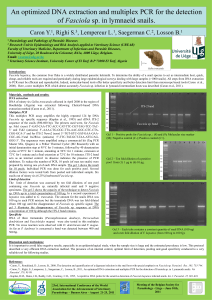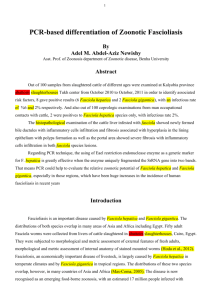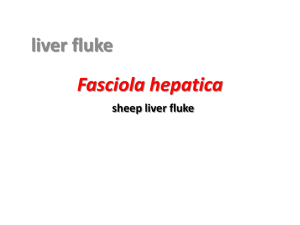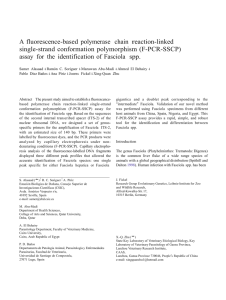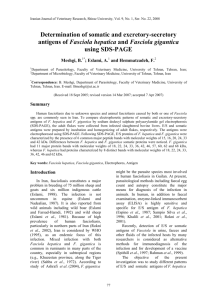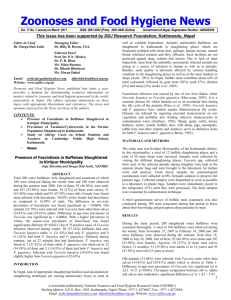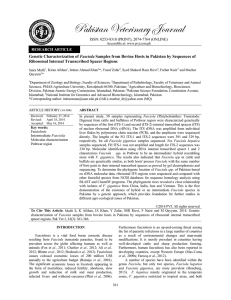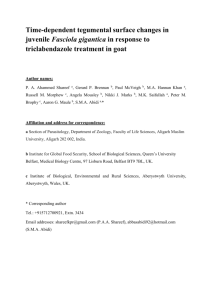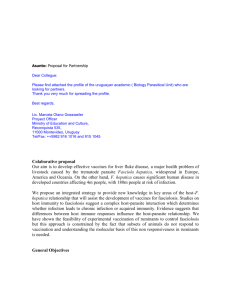DETECTION OF SALMONELLA AND E
advertisement
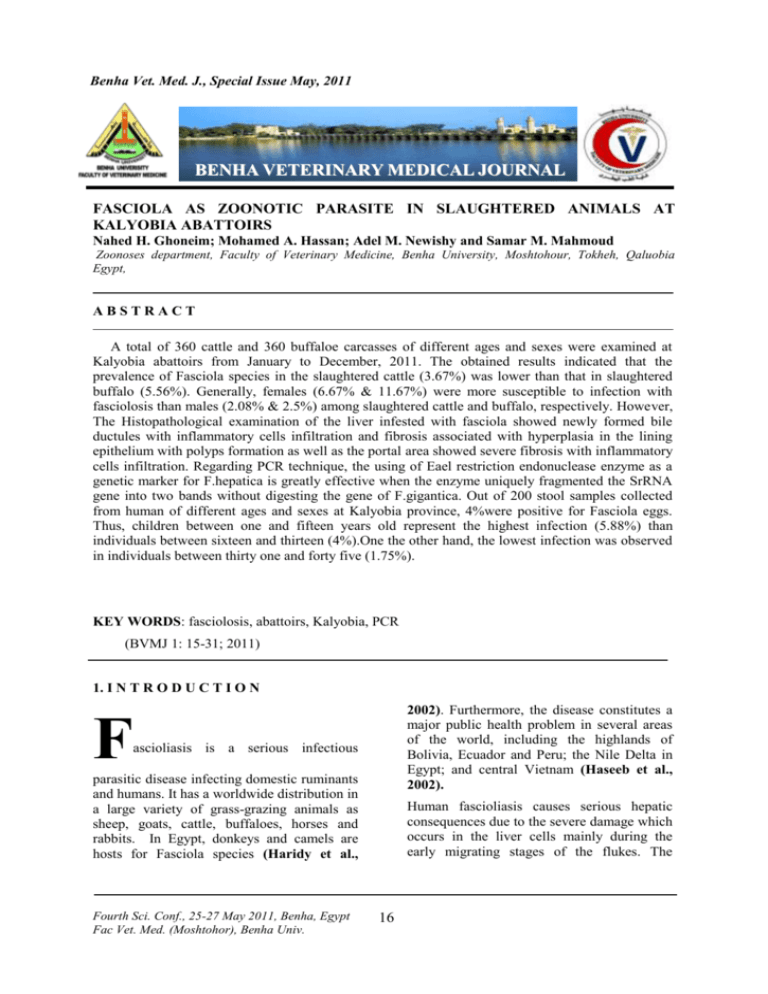
Nahed Vet. et al.Med. (2012) Benha J., Special Issue May, 2011 z BENHA VETERINARY MEDICAL JOURNAL FASCIOLA AS ZOONOTIC PARASITE IN SLAUGHTERED ANIMALS AT KALYOBIA ABATTOIRS Nahed H. Ghoneim; Mohamed A. Hassan; Adel M. Newishy and Samar M. Mahmoud Zoonoses department, Faculty of Veterinary Medicine, Benha University, Moshtohour, Tokheh, Qaluobia Egypt, ABSTRACT A total of 360 cattle and 360 buffaloe carcasses of different ages and sexes were examined at Kalyobia abattoirs from January to December, 2011. The obtained results indicated that the prevalence of Fasciola species in the slaughtered cattle (3.67%) was lower than that in slaughtered buffalo (5.56%). Generally, females (6.67% & 11.67%) were more susceptible to infection with fasciolosis than males (2.08% & 2.5%) among slaughtered cattle and buffalo, respectively. However, The Histopathological examination of the liver infested with fasciola showed newly formed bile ductules with inflammatory cells infiltration and fibrosis associated with hyperplasia in the lining epithelium with polyps formation as well as the portal area showed severe fibrosis with inflammatory cells infiltration. Regarding PCR technique, the using of Eael restriction endonuclease enzyme as a genetic marker for F.hepatica is greatly effective when the enzyme uniquely fragmented the SrRNA gene into two bands without digesting the gene of F.gigantica. Out of 200 stool samples collected from human of different ages and sexes at Kalyobia province, 4%were positive for Fasciola eggs. Thus, children between one and fifteen years old represent the highest infection (5.88%) than individuals between sixteen and thirteen (4%).One the other hand, the lowest infection was observed in individuals between thirty one and forty five (1.75%). KEY WORDS: fasciolosis, abattoirs, Kalyobia, PCR (BVMJ 1: 15-31; 2011) 1. I N T R O D U C T I O N F 2002). Furthermore, the disease constitutes a major public health problem in several areas of the world, including the highlands of Bolivia, Ecuador and Peru; the Nile Delta in Egypt; and central Vietnam (Haseeb et al., 2002). ascioliasis is a serious infectious parasitic disease infecting domestic ruminants and humans. It has a worldwide distribution in a large variety of grass-grazing animals as sheep, goats, cattle, buffaloes, horses and rabbits. In Egypt, donkeys and camels are hosts for Fasciola species (Haridy et al., Fourth Sci. Conf., 25-27 May 2011, Benha, Egypt Fac Vet. Med. (Moshtohor), Benha Univ. Human fascioliasis causes serious hepatic consequences due to the severe damage which occurs in the liver cells mainly during the early migrating stages of the flukes. The 16 Nahed et al. (2012) disease affects the general immune status of man, and there is no accurate method adopted for early diagnosis of such disease before the time of egg deposition (El-Bahy, 1998). The nuclear small Sr RNA genes of the two species of Fasciola were detected by using the following primers: SSU1 (5, CGACTGGTTGATCCTGCCAGTAG – 3,) Fasciola hepatica and Fasciola gigantica can generally be distinguished on the basis of their morphology, but the use of molecular methods and markers are necessary for species confirmation and to distinguish the intermediate forms (Marcilla et al., 2002 and Ashrafi et al., 2006). The two species and their intermediate forms can be discriminated by sequences of the first (ITS-1) Internal Transcribed Spacers, the 5.8S, and second (ITS-2) Internal Transcribed Spacers (ITS) of the nuclear ribosomal DNA (rDNA), 28S ribosomal ribonucleicacid (rRNA) ( Itagaki et al., 2005 & Ichikawa and Itagaki, 2010). SSU2 (3, TCCTGATCCTTCTCAGGTTCAC – 5,) The program of PCR for amplification of nuclear SrRNA was 30 cycles for 1 minute at 94οC, 2 minutes at 45οC and 3 minutes at 72οC (Stohard and Rollinson, 1997). 4.3. Restriction fragment polymorphisms profiles 1. Collection of Samples from slaughtered animal Thorough routine post mortem examination of slaughtered animals. Thus, gross inspection was done on each slaughtered animal including, the whole carcass and the internal organs. parasites in 4.4. Analysis of PCR amplified products Accurately, PCR amplified products were analysed by agarose gel electrophoresis on 1.4% gel containing ethidium bromide dye (0.5 μl /ml). Examination of Fasciola species by traditional method was carried out according the technique recommended by Carleton (1957). 3. Histopatholgical examination of naturally infested tissues It was applied according to Banchroft et al. (1996). 5. Collection and Examination of Human stool specimens 4. Characterization of Fasciola species by PCR Accurately, 200 stool samples were collected according to the technique adopted by Garcia and Bruckner (1993) and examined by: 4.1. Determination of genomic DNA 5.1. Direct smear method: (Beaver, 1950) The total DNA of the two species (Fasciola hepatica and Fasciola gigantica) was extracted by using the UNSET lysis solution according to the technique recommended by Hugo et al. (1992). One μl of the suspended pellet was checked by 0.8% gel electrophoresis for the presence of DNA. 5.2. Kato thick smear (Katz et al, 1970) 4.2. Nuclear subunit ribosomal RNA (Sr RNA) gene detection Fourth Sci. Conf., 25-27 May 2011, Benha, Egypt Fac Vet. Med. (Moshtohor), Benha Univ. length Restriction endonuclease represented by Eael (Roche Applied Science) was used to identify and differentiate the nuclear small subunit ribosomal RNA (SrRNA) gene of the two species of Fasciola. For each digestion reaction, one μl was used together with 1.2 μl of the particular enzyme buffer for a final volume of 12.2 μl. The digestion was carried out for 3.5 hrs at 37οC and the digestion products were evaluated on 2% TE agarose gels and stained with ethidium bromide. Accordingly, the restriction patterns were detected upon ultra violet transillumination and photographed. 2. MATERIAL AND METHODS 2. Detection of tissue slaughtered animals - 17 Nahed et al. (2012) 3. RESULTS Table (1): Prevalence of Fasciola species in liver of slaughtered cattle Season Winter Gender Spring Summer Autumn Total No. +ve % No. +ve % No. +ve % No. +ve % No. +ve % 60 1 1.67 60 1 1.67 60 1 1.67 60 2 3.33 240 5 2.08 females 30 1 3.33 30 2 6.67 30 2 6.67 30 3 10.00 120 8 6.67 Total 90 2 2.22 90 3 3.33 90 3 3.33 90 5 5.56 360 13 3.61 Males Table (2): Prevalence of Fasciola species in livers of slaughtered buffaloes Winter Spring Summer Autumn Total Season Gender No. +ve % No. +ve % No. +ve % No. +ve % 60 1 1.67 60 2 3.33 60 1 1.67 60 2 3.33 females 30 2 30 3 10.00 30 4 13.33 30 5 16.67 120 14 11.67 Total 90 3 90 5 5.56 90 5 5.56 90 7 7.78 360 20 5.56 Males 6.67 3.33 No. 240 +ve 6 % 2.5 Table (3): Demonstration of Fasciola eggs among examined cases by Kato thick smear and direct stool examination Locality Toukh Benha No. of examined cases Positive cases % 150 7 4.67 25 - - 25 1 4.00 200 8 4.00 Shebeen El-Kanater Total 18 Nahed et al. (2012) Table (4): Age distribution among positive cases as detected by Kato thick smear and direct stool examination Age (Year) Total Positive cases % Negative cases 1 - 15 68 4 64 5.88 % 16 -30 75 3 72 4.00 % 31 -45 57 1 56 1.75 % (5): Sex distribution among positive cases as detected by Kato thick smear Table and direct stool examination SEX Total Positive cases Percent Females 107 5 4.67 % Males 93 3 3.23 % Table (6): Prevalence of Fascioliasis in correlation to residence as detected by Kato thick smear and direct stool examination Rural Urban Locality No. +ve % No. +ve % Benha 20 - - 5 - - Toukh 125 6 4.8 25 1 4.00 Shebeen El - Kanater 15 1 6.67 10 - - Total 160 7 4.3 4.38 40 1 2.5 19 Nahed et al. (2012) Fig. (1): Liver of cattle showing fibrosis in the wall of bile duct with inflammatory cells infiltration and newly formed bile ductules (a) Fig. (3): Liver of cattle showing fibrosis (f) arising from the portal area dividing the hepatic parenchyma (h) into lobules Fig. (4): Gel electrophoresis of PCR amplified Fig. (2): Liver of cattle showing part of products using specific agarose primer for characterization of Fasciola hepatica. the parasite embedded in lumen of M 1 2 3 4 5 6 7 8 9 10 11 12 bile ducts(p) associated with hyperplasia in the lining epithelium of bile ducts (bd) 830 bP with polyps formation and periductal inflammatory cells infiltration (ct). 20 M Nahed et al. (2012) Lane M: 860 bp ladder as molecular DNA marker. Lane 1: control positive for Fasciola hepatica. Lane 2: control negative for Fasciola hepatica. Lane 3, 4, 5, 7, 8, 10, 11, 12: positive (Fasciola hepatice). Lane 6, 9: negative (Fasciola gigantica). fasciolosis was showed at winter (39.08%) followed by spring (29.50%), autumn (20.33%) and summer (12.92%).. These differences may be attributed to the variation in agro-ecological conditions favorable to both the parasite and the intermediate host. The variation in climato-ecological conditions such as altitude, rainfall, temperature, livestock management system, and suitability of the environment for survival and distribution of the parasite as well as the intermediate host. One of the most important factors that influence the occurrence of fasciolosis in a certain area is availability of suitable snail habitat (Urquhart et al., 1996). DISCUSSION Prevalence of Fasciola species The present results achieved in Table (1) declared that the overall prevalence of Fasciola species in slaughtered cattle (3.61%) this result is found within the range recorded by Haridy et al. (1999) 3.54% in Egypt and Kithuka et al.(2002) 3.5% in Coast province(Kenya) .On the contrary, higher prevalence was reported by Phiri et al (2005) 53.9% in Zambia and Bernardo et al.(2011) 28.24% . On the other hand, the present results were higher than Youssef-Fatma (2009) 2.34%. Concerning Fasciola species in buffalo, Table (2) declared that their prevalence in slaughtered buffalo (5.56%) was higher than that in slaughtered cattle (3.61%). Nearly similar findings were recorded by Mahdi and Al -Baldwi (1987) 5.86%. On the contrary, higher prevalence was noted by Shaikh et al. (1983) 78.73% and El Shazly et al. (2002) 62.7%.The lower prevalence of fasciolosis was mentioned by Haridy et al. (1999) 1.58%. The seasonal dynamics of Fasciola species in cattle and buffalo regarding Table (1) & (2) it is evident that the highest percentage was detected in Autumn (5.56%) and (7.78%) ,followed by Spring & Summer (3.33%) and (5.56%) then Winter (2.22%) and (3.33%), respectively. The highest prevalence in autumn may be explained as Fasciola cercaria and Lymnaea snails have been found to survive better at 25-20 c which explains the higher prevalence at Autumn, however, the most important factors influencing the prevalence of Fasciola are temperature and moisture which affect the hatching of fluke ova, the viability of encysted metacercaria and population of snails (Ollerenshaw, 1958).Our results agree with Swarup and Pachauri (1987) and Chaudhri et al. (1993).O On contrast, Khan et al. (2009) reported that higher incidence of In general, females (6.67% &11.67%) were more susceptible to infection with fasciolosis than males (2.08% & 2.5%) among slaughtered cattle and buffalo, respectively as shown in Tables (1) &(2). These results agree, quite well, with those of Phiri et al. (2005) 2. Histopathological changes due to Fasciola species The Histopathological examination of the liver due to Fasciola species revealed the portal area showed newly formed bile ductules with inflammatory cells infiltration and fibrosis (Fig.1). Part of the parasite was embedded in the lumen of the bile ducts associated with hyperplasia in the lining epithelium with polyps formation and periductal inflammatory cells infiltration (Fig.2). The fibroblasts were originated from the portal areas and dividing the hepatic parenchyma into 21 Nahed et al. (2012) lobules (Fig.3). These results come in accordance with those reported by Duff et al. (1999) and Ansari-Lari & Moazzeni (2006). 3. Characterization of Fasciola species by PCR Concerning the application of PCR for differentiation of two species of Fasciola by using specific primers of F.hepatica, results achieved in figure (1) indicated that 8 samples had positive bands related to F. hepatica and 2 negative bands representing F.gigantica. Consequently, the using of Eael restriction endonuclease enzyme as a genetic marker for F.hepatica was greatly effective when the enzyme uniquely fragmented the SrRNA gene into two bands without digesting the gene of F.gigantica. The current results were nearly similar with those obtained by Huang et al. (2004) and Lin et al. (2007). On the other hand, simple and rapid PCR – RFLP to distinguish F. hepatica from F. gigantica, based on a 618 bp long sequence of 28 SrRNA gene recently obtained from liver fluke populations, and found few nucleotide differences between both Fasciola species and no intraspecific variation between each species (Marcilla et al., 2002). However, a genetic variation between F. gigantica and F. hepatica with amplification fragment based on a 400500 bp is described by Ramadan and Saber (2004). Accordingly, one can confirm that PCR is simple, rapid and accurate tool for differentiation of the two species of Fasciola as compared with those of morphological, pathological or immunological techniques. 4. Fasciola eggs in human stools Table (3) idicated that 4% of the examined cases were positive for Fasciola eggs. The obtained result was in agreement with the result given by Hillyer (1999) (4%). Whereas, lower results was reported by WHO (1995) (3%). Other authors reported higher positive rates as El-Ahl et al. (2007) (10.4%). Results achieved in Table (4) declared that children between one and fifteen years old represent the highest infection (5.88%) than individuals between sixteen and thirteen (4%).One the other hand, the lowest infection was in individuals between thirty one and forty five (1.75%).The obtained result was in agreement with result given by El-Shazly et al. (2009). Table (5) indicated that females (4.67%) were more exposed to infection more than males (3.23%). The obtained result was in agreement with the result given by MasComa (2005) and Curtale et al. (2007). This may be due to immune suppression of females by other physiological activities such as menstruation and pregnancy. Also females are associated more with the washing of clothes and kitchen utensils and meal preparation in houses and management of freshwater plants that potentially carry attached metacercariae (Estebane et al. , 2003). It is evident from the results recorded in Table (6) that infection was higher in rural areas (4.38%) than urban areas (2.5%).This results come in accordance with those reported by El-Shazly et al. (2009) and Curtale et al. (2007) 22 Nahed et al. (2012) 5. REFERENCES Z.and Mas-Coma, S. (2007) :Human fascioliasis infection: gender differences within school-age children from endemic areas of the Nile Delta, Egypt Trans R Soc Trop Med Hyg., 101(2):155-160. 1. Ansari-Lari, M. and Moazzeni, M. (2006): A retrospective survey of liver fluke disease in livestock based on abattoir data in Shiraz, south of Iran. Preventive. Vet. Med., 73 (1): 93-96. 2. Ashrafi, K.; Valero, M.A.; Panova, M., Periago, M.V.; Massoud, J. and MasComa, S. (2006): Phenotypic analysis of adults of Fasciola hepatica, Fasciola gigantica and intermediate forms from the endemic region of Gilan, Iran. Parasitol. Inter., 55, 249–260. 3. Banchroft, J.D.; Stevens, A. and Turner, D.R. (1996): Theory and practice of histological techniques. Fourth Ed. Churchil Living stone ,New york , London , San Francisco, Tokyo 4. Beaver, (1950): Direct smear method of stool examination .J.parasitol. 36,451.Quoted from: Grade wohl's clinical laboratory methods in diagnosis. Edited by franked, S.; Retman, S. and Sonninwirth, A. C. (1970): The C.V.Mos by company-saint lows 5. Bernardo, C.C.;Carneiro, M.B,.; Avelar, B.R.; Donatele, D.M.;Martins, I.V. and Pereira, M.J. (2011):Prevalence of liver condemnation due to bovine fasciolosis in Southern Espírito Santo: temporal distribution and economic losses. Rev Bras Parasitol Vet., 20(1):49-53. 6. Carleton, H. M. (1957): Histopathological technique for normal and pathological tissues and the identification for parasites. 3rd Ed., London, Oxford University Press, New York: 308. 7. Chaudhri, S .S.; Gupta, R. P.; Kumar, S.; Singh, J. and Sangwan, A . K. (1993): Epidemiology and control of Fasciola gigantica infection of cattle and buffaloes in Eastern Haryana, India. Indian. J. Anin. Sci., 63:600-605. 8. Curtale, F.; Hassanein, Y.A.; Barduagni , P.; Yousef, M.M.; Wakeel, A. E.; Hallaj, 9. Duff, J.P.;Maxwell, A.J. and Claxton, J.R. (1999): Chronic and fatel fascioliasis in llamas in the U.K. Vet. Rec. 145 (11): 315-316 10. El-Ahl, S.A.; El Shazly, A.M.; El Shafei ,A,A.; Hegazi, M.A.; El-Dardiry, M.A.(2007): Risk factors contributing to fascioliasis endemicity in a focus in Dakahlia Governorate1-human host.. J Egypt Soc Parasitol., 37(3):1075-90. 11. El-Bahy, N.M. (1998): Strategic control of fascioliasis in Egypt. Review article. Submitted to the Continual Scientific Committee of Pathology, Microbiology and Parasitology 12. El-Shazly, A.M,: El-Beshbishi, S.N.; Azab, M.S,; El-Malky, M.; Abdeltawab, A.H. and Morsy, A.T. (2009): Past and present situation of human fascioliasis in Dakahlia Governorate, Egypt. J Egypt Soc Parasitol., 39(1):247-262. 13. El-Shazly, A.M.; El-Wafa, S.A.; Haridy, F.M.;Soliman, M.; Rifaat, M.M. and Morsy, T.A. (2002):Fascioliasis among live and slaugthered animals in nine centers of Dakahlia Governorate. J Egypt Soc Parasitol., 32(1):47-57. 14. Esteban, J.G.; Gonzalez, C.; Curtale, F., Munnoz-Antoli, C.; Valero, M.A.; Bargues, M.D.; El-Sayed, M.; El-Wakeel, A.A.W.; Abdel-Wahab, Y.; Montresor, A.; Engees, D.; Saevioei, L. and MasComa, S. (2003): Hyperendemic Fascioliasis associated with Schistosomiasis in villages in the Nile delta of Egypt. Am. J. Trap. Med. Hyg., 69: 429-437. 15. Garcia, L.S. and Bruckner, D.A. (1993): Macroscopic and Microscopic examination of Fecal Specimens. Diagnostic Medical 23 B Nahed et al. (2012) Parasitology. 2nd edition. Edited by: Garcia LS, Bruckner DA. Washington. American Society for Microbiology: 501-535. 16. Haridy, F. M.; Ibrahim, B. B.; Morsy, T. A. and El – Sharkawy, I. M. (1999): Fascioliasis an increasing zoonotic disease in Egypt. J. Egypt. Soc. Parasitol., 29 (1): 35-48 17. Haridy, F.M.; Morsy, T.A.; Gawish, N.I.; Antonios, T.N. and Abdel Gawad, A.G (2002): The potential reservoir role of donkeys and horses in zoonotic fascioliasis in Gharbia Governorate, Egypt. J. Egypt. Soc. Parasitol., 32(2): 561-570. 18. Haseeb, A.N.; el-Shazly, A.M.; Arafa, M.A. and Morsy, A.T. (2002): A review on fascioliasis in Egypt. J Egypt Soc Parasitol., 32(1):317-354. 19. Haswell-Elkins, (1996): Food-born .C (Ed.) Diseases,twentieth pp. 1461-1464. M.R.; Elkins, D.B. trematodes. In; Cool, G Manson's Tropical ed.Saunders ,London, 20. Hillyer, G.V. (1999): Immunodiagnosis of human and animal fasciolosis. In: Dalton, J.P. (Ed.), Fasciolosis. CAB International Publishing, Wallingford, Oxon, UK, pp. 435–447. 21. Huang, W. Y.; Wang, H. B. and Zhu, C. R. (2004): Characterization of Fasciola species from Mainland China by ITS-2 ribosomal DNA sequence. Vet. Parasitol ., 120(1-2): 75-83. 22. Hugo, A.; Stewart, V.; Gast, R. and Byars, T. (1992): Purifiation of mt – DNA using PCR procedure. In "Protocol in protozoology" Lee, J. and Soldo, A. Eds, Eoc. Protozoologist, Lawrence pp. 71-74. 23. Ichikawa, M. and Itagaki, T. (2010): Discrimination of the ITS1 types of Fasciola spp. basedon a PCR–RFLP method. Parasitology Research, 106: 757– 761. 24. Itagaki, T.; Kikawa, M.; Sakaguchi, K.; Shimo, J.; Terasaki, K.and Shibahara, T. (2005): Genetic characterization of parthenogenetic Fasciola species In Japan on the basis of the sequences of ribosomal and mitochondrial DNA. Parasitology 131, 679–685. 25. Katz, N.; Coelho, P.M. and Pellegrino, J. (1970): Evaluation of kato Quantitive method through the recovery of S.mansoni eggs added to human faeces. J.parasitol., 56:1032-1033. 26. Khan, M.K.; Sajid, M.S.; Khan, M.N.; Iqbal, Z. and Iqbal, M.U. (2009): Bovine fascioliasis : prevalence, effects of treatment on productivity and cost of benefit analysis in five districts of Punjab, Pakistan. Res. Vet. Scio., 80(3): 44-56. 27. Kithuka, J. M.; Maingi, N.; Njeruh, F. M. and Ombui, J. N. (2002): The prevalence and economic importance of bovine fascioliasis in Kenya – an analysis of abattoir data. Onderstepoort J. Vet. Res., 69 (4): 255-262. 28. Lin, R.Q., Dong, S.J., Nie, K., Wang, C.R, Song, H.Q., Li, A.X., Huang, W.Y. and Zhu, X.Q. (2007): Sequence analysis of the first internal transcribed spacer of rDNA supports the existence of the intermediate Fasciola between F. hepatica and F. gigantica in mainland China. Parasitol Res., 101(3): 813-817. 29. Mahdi, N. K. and Al – Baldawi, F. A. (1987): Hepatic fascioliasis in the abattoirs of Basrah. Ann. Trop. Med. Parasitol., 81 (4): 377-379. 30. Marcilla, A.; Bargues, M. D. and Mas – Coma, S. (2002): A PCR – RFLP assay for the distinction between F. hepatica and F. gigantica. Mol Cell Probes., 16 (5): 327333. 31. Mas-Coma, S. (2005): Epidemiology of fascioliasis in human endemic areas. J. Helminthol., 79: 207–216. 32. Ollerenshw, C. B. (1958): Climate and liver fluke. Agriculture, 65: 231-252. 24 Nahed et al. (2012) 33. Phiri, A. M.; Phiri, I. K.; Siziya, S.; Sikasunge, C. S.; Chembensofu, M. and Monrad, J. (2005): Seasonal pattern of bovine fascioliasis in the kafue and Zambezi cachment areas of Zambia. J. Vet. Parasitol., 134: 87-92. 34. Ramadan, N. I. and Saber, L. M. (2004): Detection of genetic variability in non human isolates of F. hepatica and F. gigantica by the RAPD-PCR technique. J. Egypt. Soc. Parasitol., 34 (2): 679-689. 35. Shaikh, H. U. D.; Huq, M. M.; Karim, M. J. and Khan, M. M. M.(1983): Parasites of zoonotic importance in domesticated ruminants. Pakistan Vet. J., 3 (1): 23-25. 36. Stohard, J. and Rollinson, D. (1997): Molecular characterization of Bulinus globosus and Fasciola in Zanziban and an investigation of their roles in the epidemiology. Sco. Trop. Med. Hyg., 91: 353-357. 37. Swarup, D and Pachauri , S. P. (1987): Epidemiological studies on fascioliasis due to Fasciola gigantica in buffaloes in India. Buffalo Bulletin, 6: 4-9. 38. Urquhart, G.M.; Armour, J.L.; Dunn, A.M. ;Jenning, W. and Duncan, L.( 1996): Veterinary Parasitology. 2nd ed. Blackwell, London, UK. 39. WHO (1995): Control of foodborne trematode infections. Technical sheet no. 849, Geneva. 40. Youssef - Fatma, H.F. (2009): Recent Technique for detection of some parasitic affections in livers of slaughtered food animals. M.V.Sc Thesis (meat hygiene). Faculty of Vet. Med., Benha Univ., Egypt. 25
